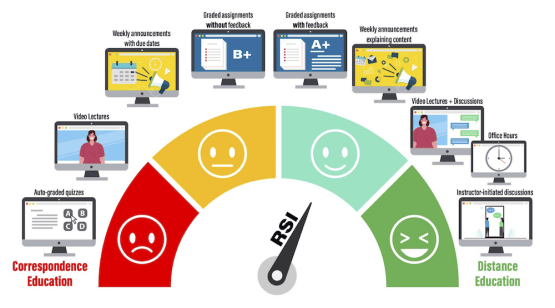Regular and Substanitive Interaction (RSI)
What It Is
Regular and Substantive Interaction (RSI) is a federal requirement for distance (online) course instructors to maintain specific engagement expectations with students to support their learning. Federal law requires interactions be initiated by the instructor, closely related to the course content, and scheduled in a predictable way.
Why It Matters
Federal Requirement
To be eligible for Title IV financial aid, distance (online) courses offered by accredited institutions must “support regular and substantive interaction between the students and the instructor, synchronously or asynchronously” (Higher Education Opportunity Act, Pub. L., 2008). Some online courses are considered correspondence courses, which do not require instructors to maintain RSI with students (Figure 1); however, such courses are not eligible for federal financial aid per 34 CFR § 668.8(m). At William & Mary, all online courses for academic credit are distance (online) education courses; therefore, instructors must comply with the federal RSI regulation.
Figure 1
Continuum of Communication for Regular and Substantive Interaction (RSI)

Note. Available from https://oscqr.suny.edu/rsi/
Benefit for Students’ Learning
Maintaining RSI with students can be achieved via multiple pathways, which increase student engagement, support students’ learning through specific feedback and individualized guidance, and strengthen classroom communities.
Apply It
RSI’s exact definition and practical guidelines “must be applied on a case-by-case basis to each institution and its academic program” (U.S. Department of Education, 2022, p. 3). W&M instructors of online courses must include at least two pathways for RSI. Figure 2 provides several example pathways for establishing RSI. Remember, because the focus of RSI is documentation of these practices, evidence must be present in a course’s Blackboard site and syllabus before students are enrolled (i.e., auditable). Instructors are encouraged to include other instructional activities to demonstrate RSI in their courses.
Figure 2
Pathways for Establishing Regular and Substantive Interaction (RSI)
| Pathway | Not Enough If | Must Be |
| Direct Instruction | Pre-recorded videos of instruction are available to students. | “live, synchronous instruction where both the instructor and the student are online and in communication at the same time” (USDOE, 2022, p. 5). |
| Feedback | “Auto-graded” feedback is provided based on a programmed system such as Blackboard quizzes. | “instructor evaluates the student’s work and provides specific feedback to the student about the work” (USDOE, 2022, p. 5). |
| Office Hours | Instructors invite students to meet if students make an appointment. | “instructors made themselves available at a specific scheduled time and through a specific modality” (USDOE, 2022, p. 4), without requiring students to make appointments in advance. |
| Group Discussion | Instructors create discussion space and do not return to it until grading students’ response in the discussion space. | instructors facilitate and contribute to the discussion and allow students to respond to the posts or sharing from the instructors and other students before being graded. |
Resources
- Read: RSI Policy-Related Documents from OLC, UPCEA, WCET
- Read: RSI Policy-Related Documents from the U.S. Department of Education
- Read: Guidelines for RSI from other institutions:
Tips for different engagement practices
- Engage: Academy- Inclusive Teaching for Higher Education
- Read: Building Community in the Classroom
- Read: STLI Drive Thru Pedagogy Post-Dialogic Engagement
- Read: Six Essentials for Online Group Assignments
- Read: Scaffolding Success: The Instructor’s Role in Facilitating Online Discussions
References
Higher Education Opportunity Act, Pub. L. No. 110-315. (2008). https://www.govinfo.gov/content/pkg/PLAW-110publ315/pdf/PLAW-110publ315.pdf
U.S. Department of Education. (2022). Letter to WCET State Authorization Network. Office of Postsecondary Education. https://wcet.wiche.edu/wp-content/uploads/sites/11/2022/11/RSI-Response-letter-signed.pdf
Cite This Resource
Studio for Teaching & Learning Innovation. (2025, July). Regular and Substanitive Interaction (RSI) [Teaching resource]. https://stli.wm.edu/academicresources/regular-and-substantive-interaction-rsi-resources/
Updated 7/2025